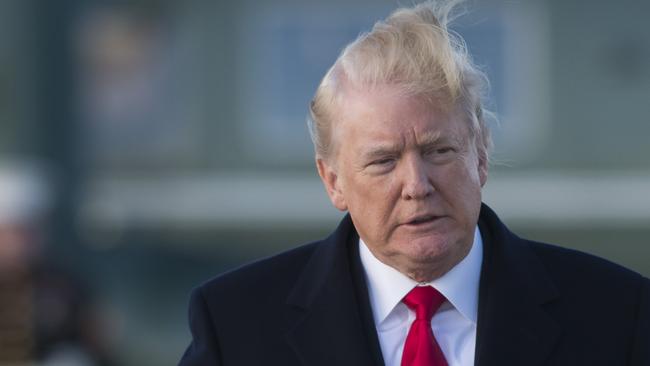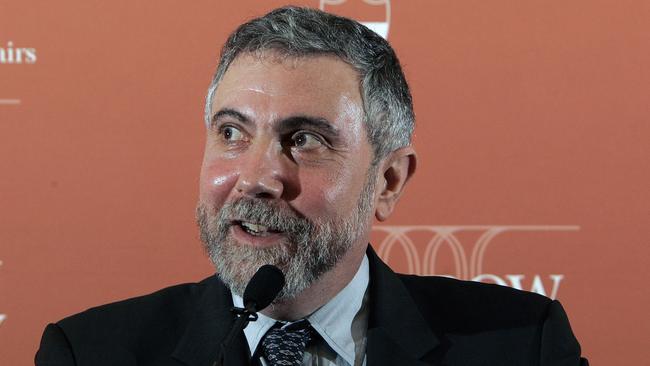Terry McCrann on the share market dive: It’s different to GFC or 1987 collapse
THIS is the correction Wall Street had to have. For us, it is the correction we do not need but cannot avoid, writes Terry McCrann.
Terry McCrann
Don't miss out on the headlines from Terry McCrann. Followed categories will be added to My News.
THE spectacular rise on Wall St since Donald Trump’s victory in November 2016 was built on a bucketload of expectation that began to defy all reality. Reality is now catching up, very quickly.
The 15-month rise boosted the Dow Jones by 44 per cent. The two-day slump has taken back a little under 7 per cent.
ASX SHEDS $28B AS INVESTORS SCRAMBLE FOR THE EXITS
AUSTRALIAN STOCKS TIPPED TO FALL FOLLOWING US SLUMP
TERRY MCCRANN: WATCH WALL ST NOT LOCAL MARKET AND CANBERRA
The impact in Australia has been worse because we didn’t get anything like the benefit on the upside. Wall St dragged all markets around the world up, but it only dragged our market up by 12 per cent.
When the dust settles tonight, we will have given back as much as half of that gain. And there’ll be more to come — over in New York and in Australia.
The year ahead is clearly going to be turbulent and volatile.
But it is not going to be 2008 over again, when the entire world’s financial system was rocked to its core and the entire developed world — with very few exceptions, of which Australia was one — plunged into its worst recession since the 1930s.
It has also — literally — not been 1987 all over again either.
Yes, the overnight fall was the biggest single day point fall ever in the Dow Jones — more than double that of ‘Black Monday’ in October 1987.
But the Dow Jones is now 10 times the level it was in 1987. Back then the fall added to a thumping 20 per cent; overnight it was less than 5 per cent.
And whereas in 1987, the underlying economy was in bad shape, the US economy right now is looking pretty good.
Indeed, that was precisely the proximate trigger for the plunge — the dawning realisation that US interest rates were headed relentlessly higher.
The ‘easy money’ days for share prices were over. Tomorrow’s prices will have to reflect real corporate performance; and share prices are back to competing with fixed interest investments for investor money.
Obviously, Australian investors are now hostage to what happens day-to-day on Wall Street — and the reactions of policy makers.
Tighten your seat belts; it’s going to be a rocky ride. But we won’t be going over the cliff.

It took just 15 months from his election for Trump to deliver a slashing in the US company tax rate from 35 to 20 per cent; AND big personal tax cuts as well.
We can’t agree on cutting our company rate from 30 to just 25 per cent; and even then only over 10 years.
The Prime Minister is throwing out big hints of personal tax cuts, but at best they are going to be modest, very modest.
Friday’s fall on Wall Street gave back barely 5 per cent of the Trump increase (2.5 per cent of 44 per cent).
Our drop yesterday gave back a much bigger 13 per cent of our post-Trump rise (1.6 per cent of 12 per cent).
We didn’t go up by as much as Wall Street, or Hong Kong, or Tokyo or Frankfurt etc; we are at risk of going down by more than Wall Street does.
I’m not so sure about the others, they are flakier.
Now the reason for the dramatic surge on Wall Street was a combination of anticipation of what President Trump might deliver and a certain nonchalance about what the Fed (the US Federal Reserve, their version of our Reserve Bank) would deliver: slowly rising official interest rates.

This didn’t necessarily make that combination irrational. Yes, higher interest rates are generally negative for share prices, as bonds and other fixed interest investments become relatively more attractive and money tends to flow from shares to them.
Also as rates rise, money for speculation into the sharemarket becomes more expensive or simply unavailable — just as, for exactly those same reasons, rising rates are negative for property prices.
But working powerfully in the opposite direction was what the Trump agenda — tax cuts, a huge infrastructure spend and more broadly “backing American businesses” — promised to do for the economy, for jobs and for profits.
Then add on America’s dominance in the 21st century space of Amazon, Apple, Facebook and Google. All of which, not exactly incidentally, they’ve got and we don’t (and we won’t get by handing over a big chunk of Melbourne’s Federation Square to Apple).
All this is very different to both 2008 and 1987, when in both cases financial markets were riding for an almighty fall. And they, well, fell.
Yes, we are likely to get more volatility on Wall Street as we march through 2018. There’ll be days when it looks like it is heading for the cliff; there will be days when it looks like we are back to boom.
But abstracting from left field geopolitical shocks, the US market won’t crash; it will go broadly sideways.
US interest rates — both the official short-term one and long bond yields — are going to be the “swing factor”.
The pace at which they rise will both be driven by what’s happening in the US economy and US financial markets and in turn will play into what’s happening.
On a day-to-day basis our market will continue to be made “overnight on the other side of the Pacific”.
The really important thing is that the very broadbased global economic upturn will continue.
If anything it will be “helped” by the share market stumbles, as that makes central bankers slower to raise official interest rates.
RBA PLAYS A STEADY HAND
THAT’S, other central bankers. Our rates aren’t (and even before the Wall Street slump weren’t) going anywhere anytime soon.
If the Reserve Bank had had any thoughts of “fiddling with its rate guidance” in today’s statement — just to be clear, it hadn’t — the recent events would certainly have put paid to that.
The last thing that the RBA would want to do would be to inject any destabilisation into uncertain markets.
That doesn’t mean though that actual property lending rates won’t go up.
Our banks get about 40 per cent of their funding from global markets; as long rates rise across the world, the higher cost of that money will flow into mortgage rates.
There are various bottom lines: volatile share market going sideways; property plateauing or dipping; but a continued pretty healthy economy.



